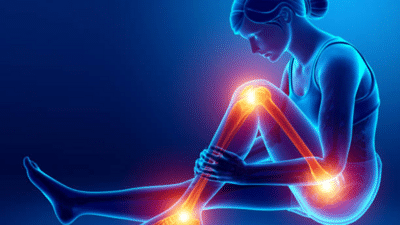Postmenopausal osteoporosis: Know the risk factors; what you can and can't change

Menopause is the permanent cessation of menstruation due to loss of ovarian follicular activity.
It is a physiological event ,a phase when a woman is faced with many hormonal changes which can be associated with several short term and long term health effects.
There may be vasomotor symptoms like hot flushes; psychological symptoms like irritability, mood swings; urogenital atrophy symptoms like vaginal dryness, recurrent UTI, painful intercourse; Dermatological symptoms like skin dryness, hair thinning etc.
But most importantly there is progressive bone loss i.e. Postmenopausal Osteoporosis . This occurs due to a decline in estrogen levels post menopause and this in turn can result in increased bone turnover and thus accelerated bone loss and increased risk of fractures. Estrogen hormone in a woman plays a protective role in bone metabolism by maintaining bone formation by osteoblasts and reducing bone resorption by osteoclasts. This is a major health problem affecting millions of women worldwide, approximately 1 in 3 postmenopausal women globally, often called a ‘silent disease’.
Clinical features : Often asymptomatic till the occurrence of a fracture.
- Back pain due to vertebral compression fractures
- Loss of height and kyphosis
- Fragility fractures of wrist, hip, spine
- Associated muscle weakness, imbalance, fall risk
Diagnosis
- Bone mineral density evaluation with DEXA studies
- Lab tests to look into secondary causes like serum calcium, phosphate, vit D levels
- Fracture risk assessment with FRAX tool which gives a 10 year risk of major osteoporosis and hip fractures.
Risk factors
There are basically two kinds of risk factors — the ones you can change and the ones you can’t. The modifiable ones include things like having a low calcium intake, smoking, drinking too much alcohol, not getting enough exercise, taking corticosteroids for a long time, or having a low BMI. These are lifestyle-related factors you can work on to lower your risk. Then there are the non-modifiable ones, like having a family history of the condition or being of Caucasian or Asian descent — those are out of your control but still important to know when thinking about your overall risk.
Management
When it comes to managing bone health , lifestyle changes and a few general measures can make a big difference. Getting enough calcium — about 1000 to 2000 mg a day — along with vitamin D (around 800 to 1000 IU daily) helps keep your bones strong. Regular weight-bearing and muscle-strengthening exercises are great for maintaining bone density and balance. It’s also important to quit smoking, drink alcohol in moderation, and take steps to prevent falls, especially as you get older. On the medication side, bisphosphonates are usually the first-line treatment. SERMs (selective estrogen receptor modulators) can help reduce the risk of vertebral fractures. Hormone replacement therapy (HRT) may be an option for women in early menopause who have symptoms, but it’s not the first choice because it can carry some risks — like blood clots and breast cancer.
Follow up and monitoring
Follow-up and regular monitoring are super important for keeping track of bone health. It’s recommended to repeat a bone density scan (DEXA) every two years to see how things are progressing. Vitamin D and calcium levels should be checked regularly to make sure they’re in a healthy range. It’s also a good idea to keep an eye on how well you’re sticking to your treatment plan and watch out for any side effects from medications. Plus, reassessing your fall risk every so often helps ensure you’re staying safe and preventing fractures in the long run.
Prevention
Early identification of at risk women in the perimenopausal period.
Lifestyle interventions initiated to slow bone loss through diet, exercise and changing habits
Encouraging regular health check ups, screening and patient education
Post menopausal osteoporosis is a major cause of morbidity in aging women but it is a preventable cause.
Early detection, patient education, lifestyle modifications and appropriate pharmacotherapy are the cornerstone of management. A postmenopausal bone health assessment is necessary to prevent the devastating consequences of fragile bones.
Dr. Preeti Prabhakar Shetty, MBBS, MD - Obstetrics & Gynaecology, Senior Consultant Obstetrician,Gynecologist, Apollo Hospitals, Bannerghatta Road, Bangalore
 Menopause is the permanent cessation of menstruation due to loss of ovarian follicular activity.
Menopause is the permanent cessation of menstruation due to loss of ovarian follicular activity.